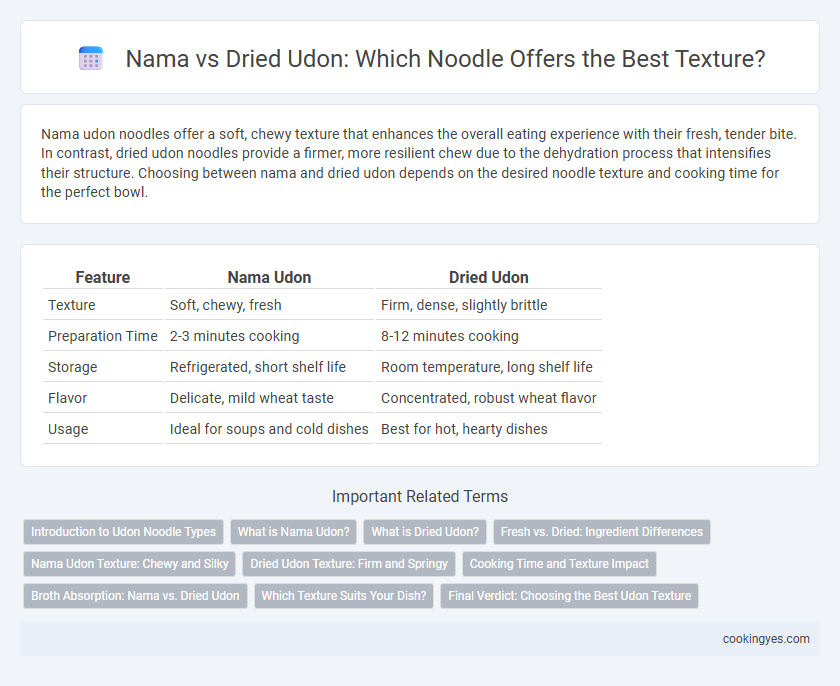Nama udon noodles offer a soft, chewy texture that enhances the overall eating experience with their fresh, tender bite. In contrast, dried udon noodles provide a firmer, more resilient chew due to the dehydration process that intensifies their structure. Choosing between nama and dried udon depends on the desired noodle texture and cooking time for the perfect bowl.
Table of Comparison
| Feature | Nama Udon | Dried Udon |
|---|---|---|
| Texture | Soft, chewy, fresh | Firm, dense, slightly brittle |
| Preparation Time | 2-3 minutes cooking | 8-12 minutes cooking |
| Storage | Refrigerated, short shelf life | Room temperature, long shelf life |
| Flavor | Delicate, mild wheat taste | Concentrated, robust wheat flavor |
| Usage | Ideal for soups and cold dishes | Best for hot, hearty dishes |
Introduction to Udon Noodle Types
Nama udon noodles feature a soft, chewy texture due to their fresh, high-moisture dough, making them ideal for soups and quick cooking. Dried udon noodles have a firmer, denser bite as a result of their low moisture content and longer shelf life, perfect for stir-fries and dishes requiring extended cooking. Understanding the texture differences between nama and dried udon helps chefs select the right noodle type to enhance specific culinary experiences.
What is Nama Udon?
Nama udon refers to fresh, uncooked udon noodles made from dough that is soft and elastic, offering a chewy and smooth texture when cooked. Unlike dried udon, which is dehydrated for longer shelf life and has a firmer, denser bite, nama udon retains moisture, resulting in a tender and slightly springy consistency. The delicate texture of nama udon enhances the flavor absorption of broths and sauces, making it a preferred choice for traditional Japanese udon dishes.
What is Dried Udon?
Dried udon noodles are dehydrated wheat-based noodles that offer a firmer, chewier texture compared to fresh (nama) udon, making them ideal for longer cooking times and extended shelf life. Unlike fresh udon, which is soft and tender due to its high moisture content, dried udon provides a dense and resilient bite, absorbing flavors well during cooking. This texture difference influences dish preparation, as dried udon noodles require rehydration and typically yield a more al dente noodle experience preferred in certain Japanese recipes.
Fresh vs. Dried: Ingredient Differences
Fresh udon noodles contain higher moisture content, resulting in a soft, chewy texture that absorbs flavors well during cooking. Dried udon noodles have reduced moisture, making them denser and firmer with a slightly more pronounced wheat flavor. Ingredient formulations differ as fresh udon incorporates more water and less salt, while dried varieties often include preservatives and additional alkaline agents to maintain texture and shelf-life.
Nama Udon Texture: Chewy and Silky
Nama udon offers a distinctive chewy and silky texture that sets it apart from dried udon. Made from fresh wheat flour and water, nama udon retains moisture that enhances its smooth, elastic bite. This fresh preparation method results in noodles that are tender yet firm, providing an ideal mouthfeel prized in authentic udon dishes.
Dried Udon Texture: Firm and Springy
Dried udon noodles possess a firm and springy texture due to their low moisture content and extended drying process, which enhances their chewiness compared to fresh counterparts. This texture allows dried udon to maintain its bite and elasticity when cooked, making it ideal for hearty soups and stir-fries. The resilient structure of dried udon ensures it holds sauces well, providing a satisfying and robust mouthfeel preferred in traditional Japanese cuisine.
Cooking Time and Texture Impact
Nama udon, or fresh udon noodles, cook quickly in boiling water, typically within 2 to 3 minutes, yielding a soft and chewy texture with a slight elasticity. In contrast, dried udon noodles require a longer cooking time, usually around 8 to 12 minutes, resulting in a firmer, denser bite due to their dehydrated nature. The extended cooking time of dried udon allows for a more substantial texture, while fresh udon provides a tender mouthfeel preferred in traditional Japanese udon dishes.
Broth Absorption: Nama vs. Dried Udon
Nama udon noodles, being freshly made and softer, absorb broth more readily, resulting in a rich and flavorful soup experience. Dried udon noodles, with their denser and firmer texture, tend to absorb broth more slowly, maintaining a chewier bite even after soaking. This difference in broth absorption impacts the overall mouthfeel and taste intensity, with nama udon enhancing broth integration and dried udon offering a distinct textural contrast.
Which Texture Suits Your Dish?
Nama udon offers a soft, chewy texture that absorbs broth flavors well, making it ideal for hot soups and delicate sauces. Dried udon has a firmer bite and longer shelf life, perfectly suited for stir-fries and dishes requiring a more resilient noodle. Choosing between nama and dried depends on the cooking method and desired mouthfeel to complement your specific udon dish.
Final Verdict: Choosing the Best Udon Texture
Fresh (nama) udon noodles offer a soft, chewy texture that enhances broth absorption and provides a delicate bite, ideal for dishes like kake udon or hot soups. Dried udon noodles deliver a firmer, slightly more resilient texture after cooking, making them suitable for stir-fried or cold udon preparations where a chewy consistency is preferred. Selecting the best udon texture depends on the cooking method and dish style, with fresh udon favored for softness and flavor infusion, while dried udon excels in versatility and longer shelf life.
Nama vs Dried for udon noodle texture Infographic

 cookingyes.com
cookingyes.com